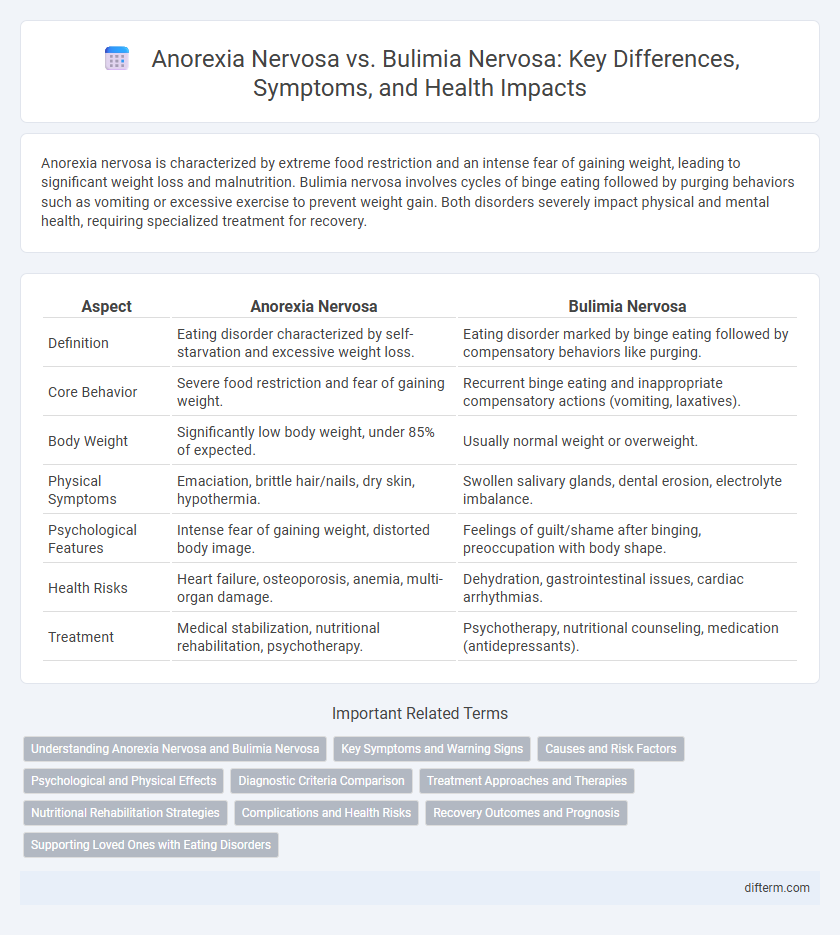Anorexia nervosa is characterized by extreme food restriction and an intense fear of gaining weight, leading to significant weight loss and malnutrition. Bulimia nervosa involves cycles of binge eating followed by purging behaviors such as vomiting or excessive exercise to prevent weight gain. Both disorders severely impact physical and mental health, requiring specialized treatment for recovery.
Table of Comparison
| Aspect | Anorexia Nervosa | Bulimia Nervosa |
|---|---|---|
| Definition | Eating disorder characterized by self-starvation and excessive weight loss. | Eating disorder marked by binge eating followed by compensatory behaviors like purging. |
| Core Behavior | Severe food restriction and fear of gaining weight. | Recurrent binge eating and inappropriate compensatory actions (vomiting, laxatives). |
| Body Weight | Significantly low body weight, under 85% of expected. | Usually normal weight or overweight. |
| Physical Symptoms | Emaciation, brittle hair/nails, dry skin, hypothermia. | Swollen salivary glands, dental erosion, electrolyte imbalance. |
| Psychological Features | Intense fear of gaining weight, distorted body image. | Feelings of guilt/shame after binging, preoccupation with body shape. |
| Health Risks | Heart failure, osteoporosis, anemia, multi-organ damage. | Dehydration, gastrointestinal issues, cardiac arrhythmias. |
| Treatment | Medical stabilization, nutritional rehabilitation, psychotherapy. | Psychotherapy, nutritional counseling, medication (antidepressants). |
Understanding Anorexia Nervosa and Bulimia Nervosa
Anorexia nervosa is characterized by severe food restriction and an intense fear of gaining weight, leading to dangerously low body weight and nutritional deficiencies. Bulimia nervosa involves recurrent episodes of binge eating followed by compensatory behaviors such as vomiting or excessive exercise, resulting in electrolyte imbalances and gastrointestinal issues. Both disorders require comprehensive treatment addressing psychological, nutritional, and medical aspects to prevent long-term health complications.
Key Symptoms and Warning Signs
Anorexia nervosa is characterized by intense fear of weight gain, significant weight loss, distorted body image, and restrictive eating habits leading to malnutrition. Bulimia nervosa involves recurrent episodes of binge eating followed by compensatory behaviors such as vomiting, excessive exercise, or laxative abuse, often accompanied by normal or fluctuating weight. Key warning signs include extreme concern with body shape, secretive eating behaviors, physical symptoms like dental erosion in bulimia, and severe fatigue or dizziness in anorexia.
Causes and Risk Factors
Anorexia nervosa is primarily caused by a combination of genetic predisposition, psychological factors such as perfectionism, and sociocultural pressure to maintain a thin body ideal. Bulimia nervosa is often linked to emotional instability, impulsive behavior, and experiences of trauma or abuse, along with genetic vulnerability to mood disorders. Both disorders share risk factors including family history of eating disorders, low self-esteem, and exposure to societal emphasis on appearance.
Psychological and Physical Effects
Anorexia nervosa primarily causes severe weight loss and malnutrition, leading to weakened bone density, muscle atrophy, and cardiovascular complications, alongside psychological effects like intense fear of gaining weight and distorted body image. Bulimia nervosa involves cycles of binge eating followed by purging, resulting in electrolyte imbalances, gastrointestinal problems such as esophageal tears, and dental erosion, accompanied by anxiety, depression, and feelings of loss of control. Both disorders significantly impair mental health and physical well-being, necessitating comprehensive treatment addressing these dual impacts.
Diagnostic Criteria Comparison
Anorexia nervosa is diagnosed primarily by significant weight loss, an intense fear of gaining weight, and a distorted body image, with individuals often presenting a body mass index (BMI) below 18.5. Bulimia nervosa diagnosis centers on recurrent episodes of binge eating followed by compensatory behaviors such as self-induced vomiting, excessive exercise, or laxative use, typically without the severe weight loss seen in anorexia. Both disorders require the presence of behavioral symptoms over a minimum duration of three months according to the DSM-5 criteria for accurate clinical assessment.
Treatment Approaches and Therapies
Treatment approaches for anorexia nervosa primarily involve nutritional rehabilitation, cognitive-behavioral therapy (CBT), and family-based therapy to restore healthy eating patterns and address distorted body image. Bulimia nervosa management emphasizes CBT targeting binge-purge cycles, pharmacotherapy with selective serotonin reuptake inhibitors (SSRIs), and psychoeducation to reduce compensatory behaviors. Both disorders benefit from multidisciplinary care integrating medical monitoring, psychological support, and nutritional counseling for effective recovery.
Nutritional Rehabilitation Strategies
Nutritional rehabilitation strategies for anorexia nervosa prioritize gradual weight restoration through structured meal plans emphasizing balanced macronutrient intake and monitored caloric increments to prevent refeeding syndrome. In bulimia nervosa, rehabilitation focuses on establishing regular eating patterns to reduce binge-purge cycles, incorporating adequate hydration and electrolyte stabilization alongside cognitive-behavioral therapy to address underlying psychological triggers. Both disorders require individualized nutritional monitoring and multidisciplinary interventions to promote sustainable recovery and prevent relapse.
Complications and Health Risks
Anorexia nervosa primarily leads to severe malnutrition, osteoporosis, heart arrhythmias, and multi-organ failure due to prolonged self-starvation. Bulimia nervosa causes electrolyte imbalances, gastrointestinal issues like esophageal tears, and dental erosion from frequent vomiting. Both disorders significantly increase the risk of cardiac arrest and psychological complications such as depression and anxiety.
Recovery Outcomes and Prognosis
Anorexia nervosa recovery outcomes often involve longer treatment durations and higher relapse rates compared to bulimia nervosa, which typically responds more quickly to therapy. Prognosis in anorexia nervosa is generally more severe due to the risk of medical complications and chronic psychological effects, whereas bulimia nervosa prognosis tends to improve significantly with early intervention and consistent cognitive-behavioral therapy (CBT). Both disorders require comprehensive treatment plans focusing on nutritional rehabilitation, psychotherapy, and ongoing medical monitoring to optimize long-term recovery.
Supporting Loved Ones with Eating Disorders
Supporting loved ones with anorexia nervosa or bulimia nervosa requires understanding the distinct behaviors and challenges associated with each disorder. Anorexia nervosa is characterized by severe food restriction and extreme weight loss, while bulimia nervosa involves cycles of binge eating followed by purging through vomiting or laxative use. Providing empathetic support, encouraging professional treatment like therapy and nutrition counseling, and fostering open communication are essential for promoting recovery and emotional well-being.
Anorexia nervosa vs Bulimia nervosa Infographic

 difterm.com
difterm.com